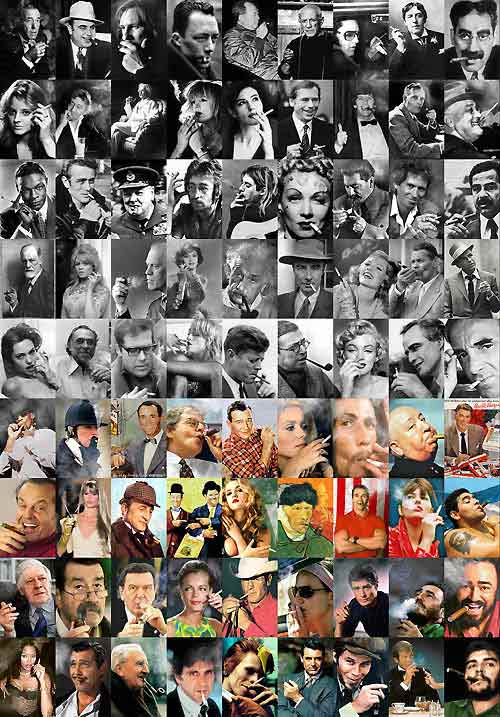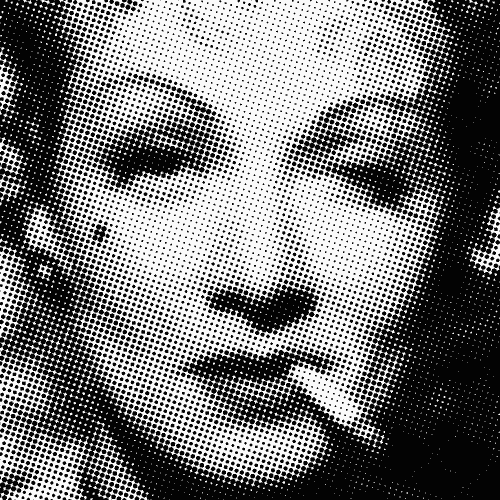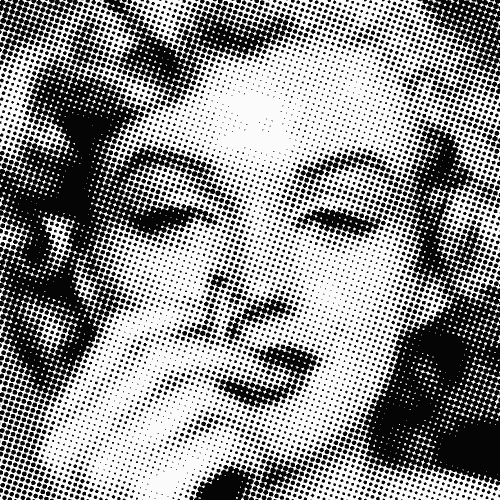
Alice Has a Hangover or We All Smoke, Plus Ćwietlik
27 XI - 19 XII 2009

Such a scandalous strategy of deceitful and perverse formulation of aesthetic "theses" and worthwhile questions has since the very beginning accompanied the career of ĆĂłdĆș Kaliska group, which Andrzej Kwietniewski joined in 1979. Manifestoes of "embarrasing art" he and his colleagues wrote disclosed rather the creative strategy of the group than the art that could result from it. We can also find this artistic aspect in the works of Andrzej Kwietniewski from the early 1980s - in his paintings produced in the convention of automatic writing/painting that recall the aesthetics of street-art and graffiti. It is enough to have a good look at successive - and there are quite a few of those - versions of memorial plaques, commemorating the famous street happening of the ĆĂłdĆș Kaliska group entitled Complete Downfall (Cracow, May 1981) or the works from the series Seven Days To Make the World in order to see that the semantic layer of the image/painting, added to a document, transforms it and even creates anew, frequently clashing with the facts as we know them. The introduction of "deceitful clues", the exposure of the structure of a multi-layered work along with the rule of repetition, borrowed from silent movies, later became a creative method, regularly used by the artists of ĆĂłdĆș Kaliska when the Performance for Photo was born and in the period beginning in the middle of the 1980s when they produced happenings/photographic compositions, based on a pastiche of distinguished works in the history of world art. Andrzej Kwietniewski, like other members of the group, was both an actor and director of these endeavours, adding erotic spice and obvious humour to many images. Some of his roles, like Venus in La strico, a corpse in Freiheit, nein danke, one of the "sisters" (with MaĆgorzata KapczyĆska) and Jesus in Deposition from the Cross, became a part of the canon of most important works by ĆĂłdĆș Kaliska from the 1980s. Andrzej Kwietniewski's talents as a director and actor were best revealed in his expressive individual works like The Memoirs of a Pervert, Most of All I Am an Avant-Garde Artist or Sick, and in his roles as director and lover he played in the 1990s in films like I Remember, Remember, Remember and Shoes.
"The logic of deconstruction demonstrates the unavoidable conflict of the unique and the recurrent. Each linguistic idiom is individual, as is the tone of someone's voice, his birth and death. Each institution, code, technique and ritual is recurrent - but what would they be if everyone of us did not fill them with our personal, individual experience?" - wrote Edward Markowski, a literary scholar from Cracow. What in this context is the latest series by Andrzej Kwietniewski, entitled We all smoke? A reflection on the conditions of our existence? A collection of portraits of people who from Kwietniewski's point of view have produced some very important works of culture of the 20th century, or finally perhaps his own biographical note? Undoubtedly the series contains an arbitrary selection of the author's idols. They are filmmakers, men of letters, philosophers and scientists, selected in order to mark the author's own sphere of fascination, influences and values. The fact that the artist has found one common denominator for all of them, namely nicotine addiction, remains a detail of secondary importance, although in certain cases it seems very difficult to imagine some of them without a cigarette or some other such attibute. Has anyone seen Al Capone, Alfred Hitchcock or Fidel Castro wihout a cigar, Sherlock Holmes wihout a pipe, Marlene Dietrich without her cigarette case or Charles Bukowski or Serge Gainsbourg without a cigarette? On the other hand, this weakness does not make these people weaker, rather more "characteristic" and "imperfect" in their perfection, humanly "unwise" and flawed.
Introducing his own image among those great figures from the world of culture, Kwietniewski justifies the choice he made among hundreds of other smokers. This great collection of people who smoke, put together by Kwietniewski and presented only in fragments at the exhibition in the FF Gallery in ĆĂłdĆș, reveals the artist's preferences in the field of film, literature and philosophy, and points to the common ground of experience, conceived as the production of culture and participation in it - in culture dominated by these undoubtedly unique and great individuals. Looking at these pictures it seems that in the 20th century nearly all creative and eminent people smoked. Among the writers selected by Andrzej Kwietniewski according to this criterion we have Jean-Paul Sartre, Arthur Miller, Julio Cortazar, Virginia Woolf, John Tolkien, Günter Grass, Oscar Wilde, Raymond Chandler, Mark Twain, Julian Tuwim, Witkacy, Suzan Sontag, Truman Capote and Samuel Beckett. Among philosophers we have Roland Barthes, Jean Cocteau, Mircea Eliade, Albert Camus, Jacques Derrida and Bertrand Russell. Among actors and musicians - Charlie Chaplin and the Marx brothers, Bob Marley and David Bowie, Tom Waits and Frank Zappa, John Lennon and Keith Richards, Marilyn Monroe and Brigitte Bardot, Nat King Cole and James Dean, as well as the aforementioned Serge Gainsbourg and Jane Birkin. Artists are represented by himself, but also by Van Gogh, Robert Mapplethorpe, Pablo Picasso, John Cage, Marcel Duchamp, WĆadysĆaw StrzemiĆski, Diego Rivera, Edward Munch and Vassily Kandinsky. Politicians are represented by Winston Churchill, Che Guevara and Fidel Castro, scientists by Albert Einstein, Robert Oppenheimer and Sigmund Freud. Kwietniewski also includes the famous Marlboro Man, as well as Laurel and Hardy and Fred Flintstone. All members of ĆĂłdĆș Kaliska are (or used to be) smokers, but Kwietniewski devoted a separate film to his colleagues, made in 2004 to celebrate the end of their long collaboration and called We All Smoke, in which we can see them dressed up as Santa Claus and doing what they like best - smoking.
Among the texts by Kwietniewski published in the catalogue of the exhibition one has a laconic title: When. It alludes to the age of New-pop which began with the installation prepared for the 20th anniversary of ĆĂłdĆș Kaliska at the Museum of Art in ĆĂłdĆș. Andrzej Kwietniewski was a co-author of the group's leading programmatic text, as well as an arranger and director of such works as Ice-cream Factory (2002), Bread for the Birds (2004), When the Nation Lives On (2005) or the famous action/performance Emblem, published in the Polish edition of Playboy magazine and later made into a film called Casting (2005), a film that presented all the girls who took part in the competition for the new Polish national emblem. This action/performance is also a point of reference in Kwietniewski's text called Attempt at the Personification of an Eagle. Andy Kwietniewski has been almost always fascinated by Andy Warhol's art and he produced works devoted to this great artist, like Divine Marilyn (1985), as early as in the 1980s. An enormous installation from the Museum of Art in ĆĂłdĆș which was a direct reference to a small collage by Richard Hamilton, entitled What Makes Contemporary Flats So Different and Attractive? (1956), was the reason why hiper-art (as members of ĆĂłdĆș Kaliska call New-pop) for the next few years dominated their minds and galleries in which they presented their works. Exhibitions like New-pop - Hyper-art, presented at the Little Gallery CSW in Warsaw (November 2004) and at the Liget gallery in Budapest, as well as Ice-cream Factory (shown in 2009 at the Reed Factory in Warsaw) are undoubtedly good examples - while decorating walls of galleries with advertising leaflets and posters offering the best known works of ĆĂłdĆș Kaliska for sale nearly stripped us all of illusions that there is still room in this cynical strategy for disinterested activity in the sphere of art. Commercialism, consumption and advertising not only subjugated the whole world, as members of ĆĂłdĆș Kaliska wrote, but also won them over.
"New-pop is painfully realistic, even mimetic. It feeds on reality, copying life like a laser xerox machine. And it does not aspire to be used in inverted commas or to some other impossible comment" - says Andrzej Kwietniewski in one of his texts. That is why the fans of ĆĂłdĆș Kaliska must have been joyously surprised by the exhibition called ABC (Atlas Sztuki, ĆĂłdĆș 2007), to this day presented in many cities, for example in Warsaw, Cracow, PoznaĆ, Szczecin and GorzĂłw Wielkopolski. Andrzej Kwietniewski is the author or co-author (with Andrzej Ćwietlik) of several charts/entries for this show, like A is for Arabia, A is for Aspect, A is for Adultery, A as abed, A is for Artist, A is for America, A is for After, A is for Alternative, and - again along with Andrzej Ćwietlik - a co-creator and man behind the original images of Alice (a Chinese Polish girl called Chan, which is the most popular surname in China) and Al, modeled on Abdelmadjid Rahmoune, an Arab living in Poland for many years because of the war goingon in his country. This is a mature and very successful attempt at describing our contemporary world with its characteristic doubts and tribulations by means of special charts or diagrams, presenting various problems, starting from the definition of identity, through interpersonal communication, politics and aesthetics, up to certain questions that arise in the interpretation of history.
"The pluralism of worlds and cultures, proposed at the exhibition and being a consequence of democratization and liberalization of social structures, is deprecated by Alice and Al who act according to a preset and limiting scheme" - writes Marta PierzchaĆa in a book called Lomicje, devoted to the last decade of ĆĂłdĆș Kaliska's activity. It is a pity that such a successful project was realized at the time when Andrzej Kwietniewski was already leaving the group - which finally happened at the meeting of the group on March 23rd, 2007, at Kwietniewski's firm request. Since then he has become "a retired member" of ĆĂłdĆș Kaliska - and the project Alice Has a Hangover is the first individual public appearance of this dedicated polemicist, collector and connoisseur who battles feminism in his own way.
Jolanta Ciesielska
Radzimowice, November 2009
Radzimowice, November 2009


When the word "man" meant mainly a male penis and Michelangelo struggled to create the biblical David, "moulding" him according to instructions to be the exact likeness of the Almighty Himself, and when in this way he showed us the details of his penis and testicles, we nevertheless hear some people say today that the Old Boss did not necesarily have to be a man.
When Lawrence Alloway came up with the term pop-art it meant only girls from boarding schools and housewives who felt the overwhelming need to come in contact with art which anyone could understand, i.e. with what is called kitsch.
When Richard Hamilton made his collage called What Makes Contemporary Flats So Different and Attractive?, he made use of those ladies and their dreams and quoted them in his art both in terms of form and content: he gave the women the roles of cleaning ladies and prostitutes while he showed the male in a discus-thrower pose of modern masculinity and put it almost in the centre of the picture.
When Andy Warhol promoted a can of Campbell's Soup and seemingly with this gesture led the housewives from the ghetto of the kitchen into the artistic and avant-garde circles, the feminists recognized it as a denial of sexism and patriarchy only because Andy was not a man.
When an artist from ĆĂłdĆș Kaliska said that he respected the second sex, female artists and critics regarded his words at least as stinking because on the one hand it is only an unambiguous praise of access to female nudity - which can be criticized only by the Church - and on the other it looks like an apparently clever piece of "dialogue" that only pretends that it shows a fragment of circulation of matter as a natural phenomenon, while in reality it shows the circulation of feminist ideas in culture - without asking for permission.
When a young but over 300 hundred years old whore with a pearl in her navel reads a note from her sponsor, we cannot be sure if this is merely a depraved insult of a woman subjected and subjugated by a man or, nevertheless, of Vermeer.
When we do not really know any more what sexual discrimination is, as everything in art is equally conventional, a good measure of masculinity and womanhood means nothing to feminist artists.
When an average representative of female, male and other art shows values that merely come close to sex-appeal, he is immediately threatened by continuous, smelly echoes of the true, female part of humanity.
When one can do in art all that fantasy will allow, a female artist can also be God, and God, in turn, can be a woman.
When...
Andrzej Kwietniewski
Next exhibition:
8 I - 5 II 2010
Copyright ©2009 Galeria FF ĆDK, Andrzej Kwietniewski, Jolanta Ciesielska